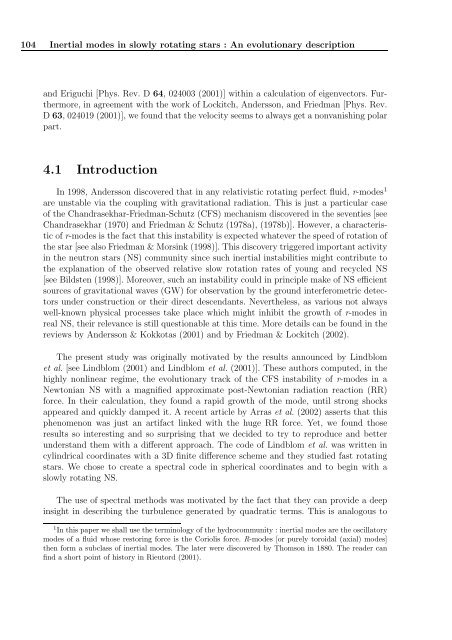Ecole doctorale de Physique de la région Parisienne (ED107)
Ecole doctorale de Physique de la région Parisienne (ED107)
Ecole doctorale de Physique de la région Parisienne (ED107)
Create successful ePaper yourself
Turn your PDF publications into a flip-book with our unique Google optimized e-Paper software.
104 Inertial mo<strong>de</strong>s in slowly rotating stars : An evolutionary <strong>de</strong>scription<br />
and Eriguchi [Phys. Rev. D 64, 024003 (2001)] within a calcu<strong>la</strong>tion of eigenvectors. Furthermore,<br />
in agreement with the work of Lockitch, An<strong>de</strong>rsson, and Friedman [Phys. Rev.<br />
D 63, 024019 (2001)], we found that the velocity seems to always get a nonvanishing po<strong>la</strong>r<br />
part.<br />
4.1 Introduction<br />
In 1998, An<strong>de</strong>rsson discovered that in any re<strong>la</strong>tivistic rotating perfect fluid, r-mo<strong>de</strong>s 1<br />
are unstable via the coupling with gravitational radiation. This is just a particu<strong>la</strong>r case<br />
of the Chandrasekhar-Friedman-Schutz (CFS) mechanism discovered in the seventies [see<br />
Chandrasekhar (1970) and Friedman & Schutz (1978a), (1978b)]. However, a characteristic<br />
of r-mo<strong>de</strong>s is the fact that this instability is expected whatever the speed of rotation of<br />
the star [see also Friedman & Morsink (1998)]. This discovery triggered important activity<br />
in the neutron stars (NS) community since such inertial instabilities might contribute to<br />
the exp<strong>la</strong>nation of the observed re<strong>la</strong>tive slow rotation rates of young and recycled NS<br />
[see Bildsten (1998)]. Moreover, such an instability could in principle make of NS efficient<br />
sources of gravitational waves (GW) for observation by the ground interferometric <strong>de</strong>tectors<br />
un<strong>de</strong>r construction or their direct <strong>de</strong>scendants. Nevertheless, as various not always<br />
well-known physical processes take p<strong>la</strong>ce which might inhibit the growth of r-mo<strong>de</strong>s in<br />
real NS, their relevance is still questionable at this time. More <strong>de</strong>tails can be found in the<br />
reviews by An<strong>de</strong>rsson & Kokkotas (2001) and by Friedman & Lockitch (2002).<br />
The present study was originally motivated by the results announced by Lindblom<br />
et al. [see Lindblom (2001) and Lindblom et al. (2001)]. These authors computed, in the<br />
highly nonlinear regime, the evolutionary track of the CFS instability of r-mo<strong>de</strong>s in a<br />
Newtonian NS with a magnified approximate post-Newtonian radiation reaction (RR)<br />
force. In their calcu<strong>la</strong>tion, they found a rapid growth of the mo<strong>de</strong>, until strong shocks<br />
appeared and quickly damped it. A recent article by Arras et al. (2002) asserts that this<br />
phenomenon was just an artifact linked with the huge RR force. Yet, we found those<br />
results so interesting and so surprising that we <strong>de</strong>ci<strong>de</strong>d to try to reproduce and better<br />
un<strong>de</strong>rstand them with a different approach. The co<strong>de</strong> of Lindblom et al. was written in<br />
cylindrical coordinates with a 3D finite difference scheme and they studied fast rotating<br />
stars. We chose to create a spectral co<strong>de</strong> in spherical coordinates and to begin with a<br />
slowly rotating NS.<br />
The use of spectral methods was motivated by the fact that they can provi<strong>de</strong> a <strong>de</strong>ep<br />
insight in <strong>de</strong>scribing the turbulence generated by quadratic terms. This is analogous to<br />
1 In this paper we shall use the terminology of the hydrocommunity : inertial mo<strong>de</strong>s are the oscil<strong>la</strong>tory<br />
mo<strong>de</strong>s of a fluid whose restoring force is the Coriolis force. R-mo<strong>de</strong>s [or purely toroidal (axial) mo<strong>de</strong>s]<br />
then form a subc<strong>la</strong>ss of inertial mo<strong>de</strong>s. The <strong>la</strong>ter were discovered by Thomson in 1880. The rea<strong>de</strong>r can<br />
find a short point of history in Rieutord (2001).
















